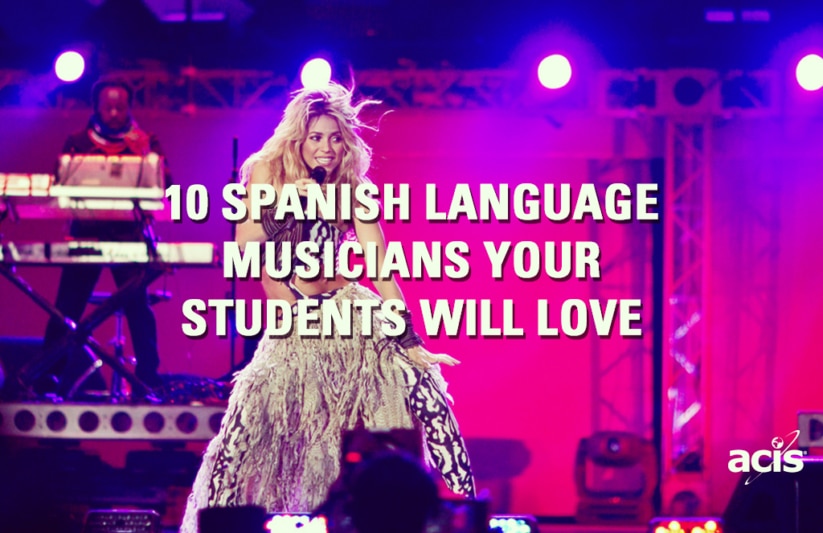Spanish Language Resources: 10 Spanish Language Musicians Your Students Will Love

The Spanish-speaking world has produced some of the world’s best and most influential music. Pioneering artists in genres such as flamenco, salsa, chicha, cumbia, pop, funk, disco and reggae have left an indelible impact on the cultural landscape of the world. Listening to music in Spanish is a fantastic and fun way to learn the Spanish language and gain insight into Spanish and Latin American culture. It’s a great way to connect what your students are learning in the classroom with the culture of the Spanish-speaking world, and it’s a fun way to soak up even more Spanish in between classes!
Looking for some Spanish-language musicians to recommend to your students?
There are countless options out there, so this is by no means an exhaustive list. Here are 10 Spanish Language Musicians Your Students Will Love:
-
Shakira (Colombia)
Perhaps the world’s biggest Latina Pop Star, your students probably already know about her, but encouraging them to listen to her Spanish lyrics with an ear for their meaning and significance could be a new challenge to help them learn. Shakira is the perfect starting point for introducing students to Latin music as her American albums are catchy and popular. She also has several albums which preceded her American debut all recorded in Spanish.
-
Manu Chao (France)
Although he wasn’t born in a Spanish-speaking country, Manu Chao is one of the world’s most famous musicians in the Spanish-speaking world. His parents fled Spain to escape Franco’s persecution and emigrated to Paris. Manu Chao’s music reflect his multi-cultural upbringing. He sings in Spanish, French, English, Italian, Arabic, Catalan, Galician, Portuguese (and occasionally others). At this point, he’s a world music icon acting as a beacon for any student learning about the global music scene.
-
Los Amigos Invisibles (Venezuela)
Originally from Caracas, Venezuela (but currently based out of Brooklyn, NY), Los Amigos Invisibles’ music is funky—perfect for any multi-cultural dance party. While their music won’t have as much political significance and depth as many other artists on this list, you won’t have a very difficult time convincing your students to listen as their beats are catchy, inspired by electronica and disco.
-
Maná (Mexico)
Considered by many to be the U2 of Latin Rock, Maná is the most successful Latin music act of all time having sold over 40 million albums worldwide. The band does not shy away from taking political stances on issues such as Puerto Rico’s movement to secede from the United States, Barack Obama’s candidacy for President of the United States, and acting as ambassador for the Food and Agricultural Organization of the United States. With a lifespan that started in 1986 and still going strong, Maná is an impressive force with which to be reckoned in Latin-American music.
-
Rubén Blades (Panama)
Another icon of Latin American music, Rubén Blades was born in Panama City, Panama where he is a beloved icon, one-time Presidential Candidate, and current minister of Tourism. He got his start in music in the 70’s while working in the mailroom at the legendary Fania Records in New York City. Soon thereafter he was performing and writing music with Willie Colón and Ray Barretto. He went on to have a hugely successful career as a Salsero, actor and activist. His music is seen as part of the fabric of Panamanian culture.
-
Amparanoia (Spain)
Originally from Granada, Spain, Amparanoia first came onto the international music scene in the mid-90’s with her rock/reggae/alternative sound. A close friend of Manu Chao, the two of them are often lumped together into a pan-cultural genre that fuses Latin musical styles and takes on various political issues. Her music is both catchy and informative when it comes to introducing students to Spanish language, as well as the Spanish culture via various musical styles.
-
Locos Por Juana (Colombia/Venezuela/Argentina by way of Miami)
If you’re looking for yet another act to synthesize a wide variety of Latin American musical styles in a funky, danceable style, look no further than Locos Por Juana. Forming as an act in Miami, FL, Locos Por Juana is comprised of musicians from Colombia, Venezuela, and Argentina borrowing sounds from their native cultures as well as Jamaica, Puerto Rico, the United States and Africa. Not only will your students want to get up and dance when they listen to these guys, they’ll also be gaining exposure to the multitude of Latin American cultures in Miami’s melting-pot culture.
-
Malacates Trebol Shop (Guatemala)
Putting Guatemala on the map of Latin American music, Malacates Trebol Shop fuses ska with rock and Latin jazz creating a catchy, upbeat pop sound. Hugely popular in their native Guatemala city, they’re great for students to learn the language as they sing clearly and distinctly, making it easy to pick out the words from their songs. Their sound is also super “poppy” so students of all ages will enjoy bopping along to their songs.
-
Cultura Profética (Puerto Rico)
Latin America has its own unique take on reggae thanks to acts like Cultura Profética. Their mellow reggae grooves are fantastic for Spanish learners as they sing slowly, clearly and beautifully. Their music is perfect for a mellow atmosphere on a sleepy summer afternoon. The subject matter of their music spans from political issues to romance so there’s variety from which to choose.
-
Los Cafres (Argentina)
Another pioneer of Latin American reggae, Los Cafres hail from Buenos Aires, putting their own stamp on Latin reggae. Their music is also very clear and easy to understand for students of español. They’ve traversed the bumpy road of Argentine politics to have a long and successful career, touring the world and making a name for themselves in the world of Latin American music (especially Latin American reggae).
What Spanish-language musicians do you listen to or recommend to your students? Let us know in the comments section below!
Check out part two for more Spanish language musicians to add to your curriculum!










